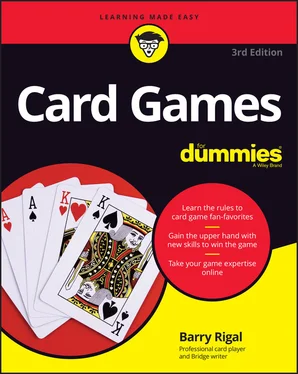In Great Britain, The Worshipful Company of Playing-Card Makers was set up in 1628 to produce cards, and a tax was introduced on every deck. Laws were also enacted to ban the import of cards; from then on, you could only play with cards of domestic origin. The year 1862 was very significant for the rise in popularity of playing cards. Along with a fall in the duty charge of playing cards, printer Thomas de la Rue patented the process for mass-producing cards. From then on, well-designed playing cards were in plentiful supply.
Each suit in U.S. and U.K. decks has 13 cards, and the rankings of the 13 vary from game to game. The most traditional order in card games today is ace, king, queen, jack, and then 10 down to 2.
 As you find throughout this book, the ranking order changes for different games. You see numerous games where 10s or perhaps jacks get promoted in the ranking order (such as in Pinochle and Euchre, respectively), and many games have jacks gambol joyfully from one suit to another, becoming extra trumps (as in Euchre).
As you find throughout this book, the ranking order changes for different games. You see numerous games where 10s or perhaps jacks get promoted in the ranking order (such as in Pinochle and Euchre, respectively), and many games have jacks gambol joyfully from one suit to another, becoming extra trumps (as in Euchre).
Also, Gin Rummy and several other games such as Cribbage treat the ace exclusively as the low card, below the two.
Before you can start any card game, you need to ration out the cards. Furthermore, in almost every game, you don’t want any other players to know what cards you have been dealt. That is where the shuffle and deal come into play.
Before the dealer distributes the cards to the players, a player must randomize, or shuffle, them in such a way that no one knows what anyone else receives. (Shuffling is particularly relevant when the cards have all been played out on the previous hand.)
The shuffler, not necessarily the player who must distribute the cards, mixes up the cards by holding them face-down and interleaving them a sufficient number of times so that the order of all the cards becomes random and unpredictable. When one player completes the task, another player (frequently in European games, the player to the right of the dealer) rearranges the deck by splitting it into two halves and reassembles the two halves, putting the lower half on top of the other portion. This is called cutting the deck.
In most games, one player is responsible for distributing the cards to the players — this player is the dealer. For the first hand, you often select the dealer by having each player draw a card from the deck; the lowest card (or, perhaps, the highest) gets to deal. After the first hand is complete, the rules of most games dictate that the player to the dealer’s left deals the next hand, with the deal rotating clockwise.
 Before the deal for the first hand, a process may take place to determine where the players sit. In games in which your position at the table is important, such as Poker or Hearts, you often deal out a card to each player and then seat the players clockwise in order from highest to lowest.
Before the deal for the first hand, a process may take place to determine where the players sit. In games in which your position at the table is important, such as Poker or Hearts, you often deal out a card to each player and then seat the players clockwise in order from highest to lowest.
The player to the dealer’s left, frequently the first person to play a card after the deal, is known as the elder or eldest hand. The younger hand is the player to the dealer’s right. These players may also be known as the left hand opponent and right hand opponent (which you sometimes see abbreviated as LHO and RHO ). The dealer may also refer to the player sitting opposite them — their partner in a partnership game — as the CHO, or center hand opponent.
 You may have been brought up on the sober concept that the right way to distribute the cards to each player is to pass them out one at a time, face-down, in a clockwise manner. However, that style is by no means the only possible, or indeed acceptable, way to deal. Games from south and eastern Europe and Switzerland, as well as tarot games, feature counterclockwise dealing and playing. And in Euchre the cards are dealt clockwise, but in batches of two or three, rather than one at a time.
You may have been brought up on the sober concept that the right way to distribute the cards to each player is to pass them out one at a time, face-down, in a clockwise manner. However, that style is by no means the only possible, or indeed acceptable, way to deal. Games from south and eastern Europe and Switzerland, as well as tarot games, feature counterclockwise dealing and playing. And in Euchre the cards are dealt clockwise, but in batches of two or three, rather than one at a time.
The due process of a deal involves the dealer taking the deck in one hand and passing a single card from the top of the deck to the player on their left, in such a way that nobody can see the face of the card. The dealer then does the same for the next player, and so on around the table. The process continues until everyone receives their due number of cards.
 Players generally consider it bad form for any player to look at their cards until the deal has been completed.
Players generally consider it bad form for any player to look at their cards until the deal has been completed.
In several games, only some of the cards are dealt out. In such games, you put a parcel of undealt cards in a pile in the middle of the table. This pile is known as the stock or talon. Frequently, the dealer turns the top card of the stock face-up for one reason or another, and this card is known as the up-card.
The cards dealt out to a player, taken as a whole, constitute a hand. It’s normal practice to pick up your hand at the conclusion of the deal and to arrange the hand in an overlapping fan shape; if you like, you can sort the cards out by suit and rank, as appropriate for the game you’re playing, to make your decision making easier. Make sure, however, to take care that no one but you can see your cards. Similarly, you shouldn’t make any undue efforts to look at any one else’s hand.
Most card games need not only a dealer (a job that changes from hand to hand) but also a scorekeeper — not normally a sought-after task. The least innumerate mathematician may be landed with the task — or the soberest player. The good news is that scientific studies have shown that the scorer generally wins the game. I wonder why!
Exposing yourself (or someone else)
In general, any irregularity in a deal that leads to a card or cards being turned over invalidates the whole deal, and the normal procedure is for the dealer to collect all the cards and start over.
However, some minor exceptions to this principle exist, and these tend to result in the dealer getting the worst penalty if they exposes cards from their own hand. But most casual games call for leniency.
Some, but by no means all, the games in this book include another preparatory phase of game play during which players have to estimate how much their hands will be worth in the latter stages of the game. The game may call for a silent estimate (as in Ninety-Nine), an announcement (Oh Hell!), or an auction (Euchre or Bridge), in which whoever makes the highest bid wins a right to form a prediction. The process may offer the option to make a single call (Euchre) or a competitive auction (Bridge). Either way, these phases of the game are known as the bidding.
Frequently, a contested auction results in one player or partnership winning the chance to determine the boss, or trump, suit. This right is also known as determining the contract. One player or side essentially promises to achieve something in the play of the cards in exchange for being allowed to determine which suit has special powers.
Читать дальше

 As you find throughout this book, the ranking order changes for different games. You see numerous games where 10s or perhaps jacks get promoted in the ranking order (such as in Pinochle and Euchre, respectively), and many games have jacks gambol joyfully from one suit to another, becoming extra trumps (as in Euchre).
As you find throughout this book, the ranking order changes for different games. You see numerous games where 10s or perhaps jacks get promoted in the ranking order (such as in Pinochle and Euchre, respectively), and many games have jacks gambol joyfully from one suit to another, becoming extra trumps (as in Euchre). Before the deal for the first hand, a process may take place to determine where the players sit. In games in which your position at the table is important, such as Poker or Hearts, you often deal out a card to each player and then seat the players clockwise in order from highest to lowest.
Before the deal for the first hand, a process may take place to determine where the players sit. In games in which your position at the table is important, such as Poker or Hearts, you often deal out a card to each player and then seat the players clockwise in order from highest to lowest. Players generally consider it bad form for any player to look at their cards until the deal has been completed.
Players generally consider it bad form for any player to look at their cards until the deal has been completed.










